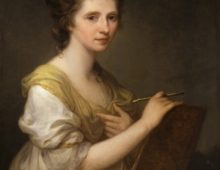Tagged with Equality
Resource : Olympe de Gouges
Olympe de Gouges was a radical feminist and one of the first people to fight for equal rights for women. She campaigned against violence and oppression and spoke out against slavery. But despite her pacifist views, her radical ideas eventually led to her death, at the guillotine, in revolutionary France.
Resource : Drawer handle with abolitionist plaque
In the late 1700s, the image of a kneeling, enslaved African man, accompanied by the words ‘Am I not a man and a brother’ became the most prominent emblem for those wishing to abolish the Transatlantic slave trade, in both Britain and America. As well as appearing in books, prints and pamphlets, it was also reproduced on an extraordinary variety of everyday and household items – from crockery and soft furnishings, to jewellery and hairpins.
Resource : Hannah More (1745 – 1833)
Hannah More (1745-1833) was a poet, playwright, anti-slavery campaigner and one of the most influential female philanthropists of the Age of Revolution. Seen by some as an early feminist, and others as an anti-feminist, she remains a controversial figure today.
Resource : Silhouette of Thomas Muir
Thomas Muir was a radical, who campaigned for political reform in Scotland. He was eventually accused of sedition and transported to Australia, following one of the most notorious and controversial trials in Scottish history. He became known as the father of Scottish democracy and one of Scotland’s five ‘political martyrs’.
Resource : Queen Marie Antoinette of France and two of her children walking in The Park of Trianon
Marie Antoinette was the wife of the last King of France, Louis XVI, before the French Revolution overthrew the monarchy. She was known for extravagance and indulgence, and was despised by the people of France. She came to symbolise the Ancien Régime – a long-standing system where the monarchy, aristocracy and Catholic Church held absolute power and privilege over ordinary people.
Resource : Handwritten declaration of American Independence
In the 1700s Britain controlled and governed extensive areas in the Americas and the Caribbean within its empire. In 1776, thirteen of the colonies in North America came together to reject British rule and the sovereignty of King George III over them, and to declare themselves independent states. This was formalised in the Declaration of Independence, the first step towards establishing a new nation – the United States of America. This handwritten version is thought to be one of the very first to reach Britain.
Resource : Skelmanthorpe Flag
The 1800s saw a series of protests and uprisings in Britain, as people campaigned against slavery, unjust taxes and laws imposed by the government and in support of fair wages, the right to vote and to have their voices heard in parliament. Protest flags, posters and banners carrying radical slogans were a popular way for campaigners to get their message across at marches and rallies, and to cooperate without endangering individuals. The Skelmanthorpe flag was created in secret, in Huddersfield, initially to honour the victims of what became known as the Peterloo Massacre, in 1819.
Resource : William Wilberforce speaking out against slavery in the House of Lords
The movement to abolish the Transatlantic slave trade was a long and difficult struggle. Campaigners for abolition used every means they could, including sugar boycotts, meetings, petitions, publications, and circulating images showing its shameful nature, to bring the issue to people’s attention in Europe. Enslaved Africans played an essential part, having long resisted their enslavement and treatment through ‘go-slows’, revolts, intellectual and religious claims, and demonstrable capacity to retain and transmit their African or creole (mixed) cultures and languages. Escaped or freed slaves forced judges and social elites to confront the issue through court cases, publications, and performances. Propelled by much of this pressure and evidence, William Wilberforce led the long political campaign to outlaw the slave trade in Britain.
Resource : Thomas Clarkson’s campaign chest
Between the 1500s and early 1800s, millions of Africans were kidnapped, sold and transported to the Americas to work as slaves, in unimaginably cruel conditions, on hugely profitable plantations, producing sugar, tobacco and other commodities. These plantations were largely owned by Europeans and Euro-Americans. Britain grew rich on the profits from this transatlantic slave trade, which were reinvested into other economic sectors. Only in the late eighteenth century did public opinion slowly begin to turn against the trade in Africans, and campaigners for abolition used every way they could to bring the issue to people’s attention in Europe.
Resource : Figures by Chelsea Waterworks, London, observing the fires of the Gordon Riots, 7 June 1780
The Gordon Riots were a series of anti-Catholic protests which took place in London between 2 and 9 June, 1780. The protests began peacefully but descended into chaos. Crowds paralysed the city with an unparalleled level of violence, with rioters attacking and setting fire to official buildings and people’s homes. The riots are considered by some historians as being the closest Britain has ever come to a full-scale revolution, and shocked fellow European powers.


